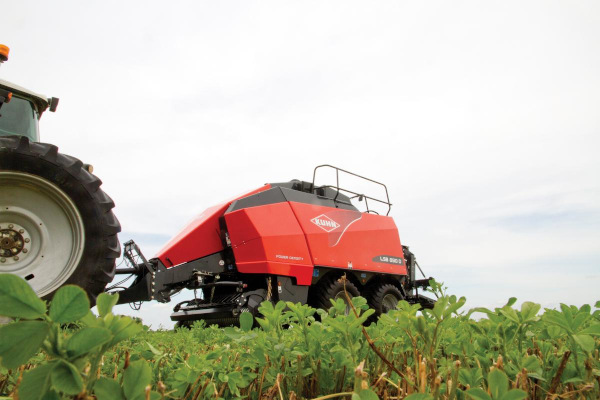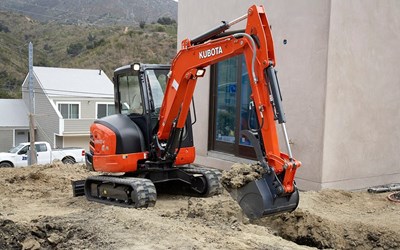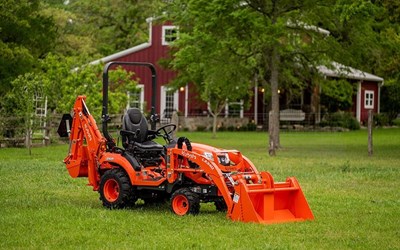Kuhn LSB 890 D OPTIFEED

Features
INTAKE OPTIONS
Intake Options to Meet Your Operation’s Needs
Optimal Crop Pickup
The pickup is designed to match the full capacity of the baler. The wide, 91” pickup, with narrow tine spacing, will leave your fields clean. Straight pickup tines help release the crop and reduce crop wrapping. Uniquely shaped crop guides result in more aggressive and efficient pickup by exposing more of the tine when needed, and by pulling the crop away from the tines as it approaches the intake. The pickup roller compresses the crop against the pickup tines reducing friction, thus reducing leaf loss and increasing baler efficiency by evening out the windrow. In extreme conditions, pivoting gauge wheels ease wheel and tire stress.
To better meet your operation's specific needs, there are three intake options available. Select from one one of our three patented Integral Rotors – the non-cutting OptiFeed rotor, or the 15- and 23-knife OptiCut cutting rotors. Availability dependent on LSB model – See Specifications
Integral Rotor Techology
Available on KUHN LSB D Series balers is our patented Integral Rotor Technology found on OptiFeed and OptiCut models. This simple, low-maintenance intake system guarantees an enormous throughput capacity at all times. The short distance between rotor and pickup tines maintains consistent crop flow. The design of this force-fed intake makes higher forward speeds possible for increased productivity and reduces crop damage. The Integral Rotor is provided with rotor tines made out of Hardox® wear plates. Hardox combines extreme hardness and toughness to reduce rotor tine wear. Longer wearing life of the rotor tines will help to provide time and money savings for the operator.
Non-Cutting, OptiFeed Rotor
When crop cutting is not required, the OptiFeed system ensures a controlled and consistent crop flow to the prechamber. This rotor design helps even out windrows by moving hay where needed for consistent bale formation. This force-fed, non-cutting intake is the perfect solution for handling tough crop conditions such as cornstalks, short straw and high-moisture crops.
Crop Feeder
The crop feeder allows for up to 15% more capacity in heavy windrows. The crop feeder compresses large windrows down into the integral rotor to improve crop flow. Standard on the LSB 1290 D, optional on the LSB 890 D.
Cutting, OptiCut Rotors
With 20 years of experience behind our cutters, the OptiCut (OC) cutting rotors are designed for unlimited intake capacity and excellent cutting quality. KUHN (OC) cutting rotors, with elliptical shaped rotor tines, are acknowledged by users as one of the best cutting systems on the market. The silage is guided and drawn down to the knives from an early stage which improves flow and cutting performance and also prevents unwanted plugging.
OptiCut 15
The OC-15 rotor, on the LSB 890 D, offers a 1.75” theoretical length of cut. The small cut provides better fermentation of forages and more absorbent straw for bedding. The KUHN patented rotor tine shape ensures a low power requirement and a superior cut quality. The knives, individually protected with a spring, can be changed easily with the standard slide tray.
OptiCut 23
The OC-23 rotor, on the LSB 1290 D, offers a 1.75” theoretical length of cut. The large 24” OptiCut rotor is designed with your operation’s high-capacity needs in mind. The knives on the OC-23 have individual hydraulic protection.
With just two levers, you can easily choose from the following knife group configurations: 0-11-12-23. Together, with the standard slide tray for easy knife changing, you not only invest in cutting quality but, above all, in driver comfort.
HIGH-QUALITY BALES
Consistent, Dense, and High-Quality Bales
Power Density – The KUHN Solution
The Importance of Bale Shape: Consistently shaped bales provide more than just aesthetic appeal. A dense, consistently filled bale represents quality in every form. Square bales are easy to handle and stack. In addition, they are much more stable during transport than a poorly formed bale. In silage applications, a square-edged bale indicates less air content, resulting in higher quality feed.
The KUHN Power Density system, a single feeder fork design, proves that a well-engineered component can eliminate complexity. This system ensures consistently filled flakes and results in heavy, square-edged bales regardless of the windrow condition.
The single feeder fork combines two functions into one mechanism, eliminating unneeded components and complexity. KUHN’s exclusive Power Density system runs at twice the speed of the plunger allowing a minimum of one flake formed per plunger stroke. This creates consistent bale shape and excellent density.
Power Density – How Does It Work?
- The integral rotor actively delivers the crop to the chamber.
- The single-acting feeder fork (blue) lifts the feed up to the measuring plates (red).
- The single-acting feeder fork continues to form the bale flake until the measuring plate is pushed back with a predetermined force.
- Once the measuring plate is pushed back, it locks the single-acting feeder fork to push the perfectly formed flake into the bale chamber.
The Bale Chamber
The specially designed bale chamber of the KUHN LSB machines is the result of more than 35 years of experience in large square balers. With the 10-foot long bale chamber, there is plenty of space to form a rock-hard, square-edged bale. The combination of aggressive retainers and special wedge-shaped doors brings maximum compaction and gentle expansion of the bale.
Forty-six plunger strokes per minute result in a high bale capacity. The plunger is guided by four large rollers with a 5" diameter for maximum service life.
Double Knotting System
The LSB 890 D and LSB 1290 D are equipped with a double-knotting system. With the electronic knotter control, the driver has accurate information concerning twine tension at all times and receives an alarm if an issue arises. The knotting progress can be monitored directly from the tractor cab.
During baling, an upper (blue) and lower (red) twine is fed to the bale, because the twine is not slipping around the bale there is no tension on the twine during the bale formation.
Step 1: As the bale reaches the desired length, the needles (gray) are activated and move upward to the knotter to start the knotting cycle. In this first step the bale is finished with the first knot.
Step 2: Once the first knot has finished the bale, the second knot connects the upper and lower twine again so the bale can be formed without tension on the twine during knotting.
HEAVY-DUTY DRIVELINE
Heavy-Duty Driveline, Maximum Protection
Heavy-Duty Driveline
KUHN uses a combination of synchronized gearboxes, drivelines and oversized chains designed for maximum life and limited maintenance. The driveline layout is simple, clean, and easy to service and maintain while minimizing the overall number of moving parts.
Instant Protection
The pickup, integral rotor and feeder fork are protected with cam-type clutches, which are automatically activated in the event of an overload.
The clutch re-engages when the operator reduces the PTO speed. This allows the operator to restart the stalled component from the driver’s seat, reducing overall downtime that is typical with slip clutches and shear bolts.
Another benefit of these clutches is that they give the ability to drive at a constant speed without worrying about plugging.
Heavy, large-diameter flywheels are featured on all LSB models. The large flywheel creates the force needed to pack the bale. This also reduces the horsepower required, and the torque spikes through the components and driveline, resulting in less fuel consumption and wear for extra longevity.
Specifications
| Model | LSB 890 D OPTIFEED |
| Bale size - height x width | 3' x 3' |
| Bale height | 35" (90 cm) |
| Bale width | 31.4" (80 cm) |
| Bale length | 2' - 10' (0.6 - 3.0 m) |
| Pickup width | 91" (231 cm) |
| Number of pickup tine bars | 5 |
| Pickup gauge wheels | Standard pivoting wheels |
| Pickup crop roller | Standard |
| Intake system | Integral rotor (with automatic cam clutch overload protection) |
| Number of knives | - |
| Minimum cutting length | - |
| Knife protection system | - |
| Knife tray | - |
| Power Density pre-chamber | Standard (with automatic cam clutch overload protection) |
| Plunger strokes / min | 46 |
| Bale pressure regulation | 3 hydraulic cylinders, controlled by self-contained hydraulic system |
| Knotting | 4 double knotters |
| Knotter fans | Standard (centrifugal) - dual hydraulic-driven |
| Machine greasing | Standard automatic central greasing with quick fill grease gun |
| Twine storage | 30 rolls |
| Power feed roller | |
| PTO power requirement | 105 hp (78 kW) |
| PTO speed (rpm) | 1,000 rpm |
| PTO type | Choice of CV PTO - 1 3/8" - 21-spline or CV - 1 3/4" - 20-spline |
| Drawbar hitch | Cat. 4 Bull-Pull |
| Hydraulic jack | Standard |
| Transport width | 8'1" - 9'1" (2.5 - 2.8 m) depending on axles and wheel size |
| Parking brakes | Standard |
| Axle | XL steered tandem axle |
| Brakes | Standard hydraulic brakes |
| Tires | 425/65R22.5 |
| ISOBUS ready | Standard |
| Electronic monitor | No monitor standard; optional CCI 50 or CCI 1200 ISOBUS monitor |
| Work lights | Standard service lights on needles and twine box |
| Road lights and signaling | Standard |
| Fire extinguisher | Standard 2.5 gallon refillable water type (dealer installed) |
| Service platform | Standard |
| Required tractor hydraulic connections | 2 SA and 1 DA |
| Machine weight | 19,000 lbs (8,618 kg) |
| Chute | Standard - hydraulic roller |
| Last bale ejector | Standard |



